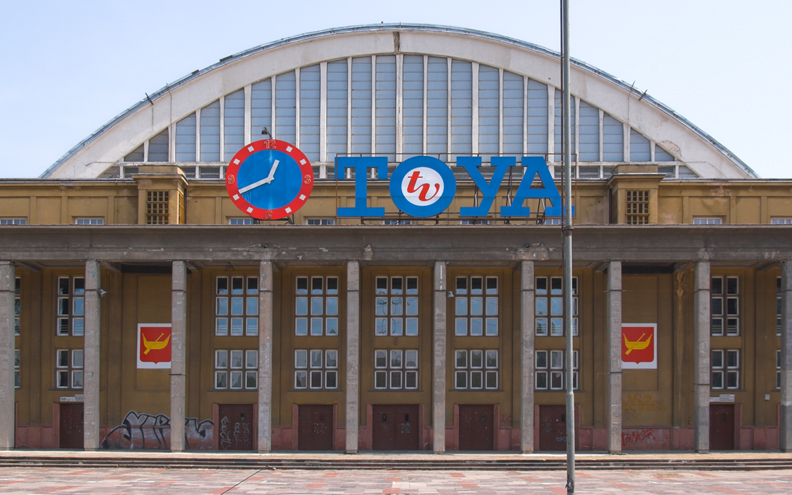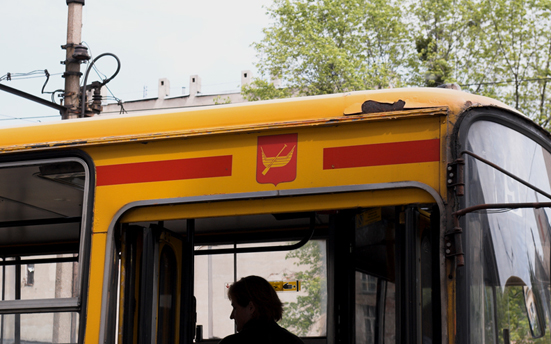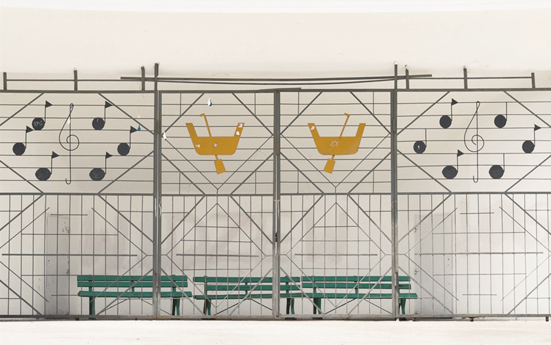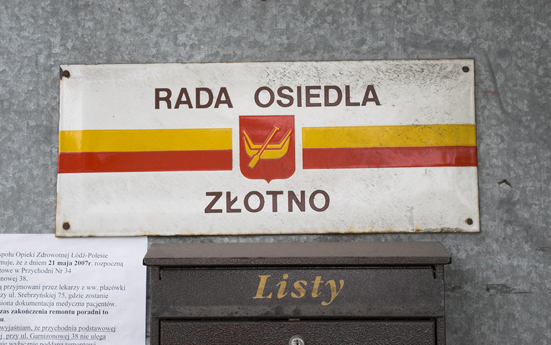 Bei meinem ersten nächtlichen Spaziergang durch Lodsch überraschte mich der Anblick zweier Tafeln, die jeweils ein goldenes mit einem Ruder versehenes Holzboot auf rotem Grund zeigten und an der Fassade eines großen leer stehenden Gebäudes angebracht waren. In den nächsten Tagen sah ich das Boot seiner Aufgabe als Transportmittel entsprechend, auf allen Fahrzeugen der städtischen Verkehrsbetriebe und als Stadtwappen im gesamten Stadtbild laufend wieder. Dass sich die Stadt mit dem Symbol ihres Namens identifiziert erschien mir plausibel, auffallend erschien mir jedoch, dass die Stadt anscheinend weder über Flüsse, sonstige Gewässer noch über reale Boote verfügte. Stattdessen fand ich vorerst nur ein paar etwas verwahrloste Brunnen vor.
Bei meinem ersten nächtlichen Spaziergang durch Lodsch überraschte mich der Anblick zweier Tafeln, die jeweils ein goldenes mit einem Ruder versehenes Holzboot auf rotem Grund zeigten und an der Fassade eines großen leer stehenden Gebäudes angebracht waren. In den nächsten Tagen sah ich das Boot seiner Aufgabe als Transportmittel entsprechend, auf allen Fahrzeugen der städtischen Verkehrsbetriebe und als Stadtwappen im gesamten Stadtbild laufend wieder. Dass sich die Stadt mit dem Symbol ihres Namens identifiziert erschien mir plausibel, auffallend erschien mir jedoch, dass die Stadt anscheinend weder über Flüsse, sonstige Gewässer noch über reale Boote verfügte. Stattdessen fand ich vorerst nur ein paar etwas verwahrloste Brunnen vor.
Angezogen von der Poesie dieses Bootes, das nicht auf einer Wasseröberflache liegt, sondern in einem imaginären Raum der Stadt Lodsch zu existieren scheint, begann ich mich mit dem Phänomen des Bootes das kein schiffbares Wasser kennt, zu befassen. Von der Lodscher Entwicklungsgeschichte ausgehend, begab ich mich auf die Suche nach dazugehörigen Flüssen und den Spuren der Existenz eines Bootes im Vorstellungsraum der LodscherInnen und der Auswirkung dieses imaginären Bootes auf Lebensvorstellungen und Visionen der StadtbewohnerInnen, die natürlich in ihrer Geschichte auch mehrmals von existentiell bedrohlichen Umwälzungen betroffen waren. Das einzige absolut Beständige im gesamten Raum von Lodsch seit über 400 Jahren scheint diese Beibehaltung des Bootszeichens im Stadtwappen zu sein, und somit die Aufrechterhaltung der Vorstellung von einem auf dem Wasser liegenden Holzboot, das in seiner wohl schönsten Ausführung, seinem wässrigen Element dort auch am nächsten, als Relief auf den gusseisernen Kanaldeckeln der Stadt zu finden verbleibt.
Was ist nun ein Boot, dessen Zweck es eigentlich ist die Fortbewegung auf dem Wasser zu ermöglichen, ohne schiffbares Gewässer? Ist ein Boot ohne Fluss nicht wie ein Haus ohne Dach? Gleicht ein auf den Kopf gestelltes Boot nicht einem Dach ohne Haus und ist nicht der Stadtraum von Lodsch also Lodsch selbst als Hausboot, das am Fluss Łódka vor Anker liegt, zu sehen? Oder ist die Stadt in der Zeit des Höhepunkts der europäischen Textilindustrie ein Gewebe aus Kanälen und Fabriken geworden, das sich aus der Arbeitsweise der Stoffherstellung in dieser Stadt gleichsam als morphologische Reihe aus Schuss und Kette dabei selbst gebildet hat?
During my first nocturnal walks across Łódź I was surprised by the sight of two boards, each showing a golden wooden boat with one oar on a red background, mounted on the front of a large, vacant building. In the following days, always again, I saw the boat, adequate to its function as means of transport, on all of the vehicles of the municipal transport service and as the town’s coat of arms all over the cityscape. That the town identified with the symbol of its name seemed plausible, yet it was conspicuous that apparently the town possessed neither rivers, and other waters, nor real boats. Initially I found only a couple of somewhat neglected wells instead.
Attracted by the poetry of the boat that does not sit on a surface of water, but seems to exist within an imaginary space of the town of Łódź, I started to attend to a phenomenon of a boat oblivious of any navigable waters. Starting from the history of Łódź’s development I betook to search for the rivers and the traces of existence of a boat within the realm of imagination of the inhabitants of Łódź and the effects of this imaginary boat onto the life concepts and visions of the inhabitants, who naturally have, more than once in the course of their history, been affected by existence threatening cataclysms. The single absolute constant in the whole space of Łódź since over 400 years seems to have been this retaining of the sign of a boat in the town’s coat of arms and therewith the maintaining of the image of a wooden boat on water, which remains to be found in its prettiest execution, closest to its water element, as a relief on the cast iron manhole covers of the town.
What good is a boat, whose aim is to actually enable transportation on water, without navigable waters? Is a boat without a river not as a house without a roof? Does not an inverted boat compare to a roof without a house and cannot the city space of Łódź, so Łódź itself, be seen as a boat house that is anchored at the bank of the river Łódka? Or did the town, in the heyday of the European textile industry, turn into become a fabric of channels and factories, which, due to the method of textile manufacturing, has itself became a morphological array of woof and warp?



WOLFGANG SOHM ÜBER DAS PROJEKT „ŁÓDŹ – BOOT”
Altlengbach im April 2008
„Łódź – Boot” stellt die Frage nach den Folgen der Zeichenhaftigkeit der Bootsabbildung im Lodscher Stadtwappen, die im gesamten Stadtbild als Funktion eines Eigentumsverweises auf möglichst jedem im öffentlichen Raum befindlichen und dem Lodscher Magistrat zugeeigneten Gegenstand zu finden ist. Als dadurch nahezu omnipräsentes Bild, das dem öffentlichen Gut so gleichgesetzt wurde, ja auf ihm geradezu „schwimmt”, bildet sich ein imaginärer Raum der Zueignung eines Gegenstandes (z.B. eines Kanaldeckels, des Rathauses usw.) als auch der Zueignung eines Vorgangs (z.B. der Strassenbahnfahrt) gleichsam als prozessualer Strom um dieses Bootsbild herum ab, das einen Raum aus Imagination (z.B. Zuordnungen wie Herkunfts- oder Eigentumsverhältnisse bezüglich eines Objekts, Nutzungsrechte o.a.) und Identifikation (der Stadt und seiner Bewohner) zu strukturieren scheint, aus dem durch die Querverbindung von Imagination und Identifikation, nämlich dem sozialen Prozess, die Stadt in das Zeichenhafte rückgekoppelt wirkt. Einem Netz von Adern gleich zeigen sich die heute öffentlichen Kanale, die in Folge der Industrialisierung die Industrieansiedlungen zur Textilherstellung im späten 19. Jahrhundert ermöglichten, die damals in der bis heute gültigen Form entstanden und auf denen die Identifikation der Stadt auch heute noch beruht. Mit Nutzung der dabei entstandenen riesigen Fabrikspaläste durch die heutige Filmindustrie sind sie typische Merkmale einer Stadt, die als Stadtwappen ein Boot führt, das ohne ausreichend schiffbare Gewässer, auf einem Netz von scheinbar fast verschwundenen Kanälen ruht.
WOLFGANG SOHM ABOUT THE PROJECT “ŁÓDŹ – BOAT”
Altlengbach April, 2008
“Łódź – Boat” poses a question about the effects of the symbolic image of the boat in Łódź’s coat of arms, which can be found throughout the whole cityscape as a reference of ownership on preferably each, publicly displayed object appropriated by the Municipality of Łódź. The almost omnipresent image, which has been equated with the public property, indeed “floats” on it, creates an imaginary space of appropriation of an object (e.g. of a manhole cover, of the city hall) as well as appropriation of a process (e.g. a tram ride) quasi as processual current around the image of the boat, that appears to be a space of imagination (e.g. correlations such as origin and ownership relations regarding an object, usage rights, and such) and identification (the city and its inhabitants), from which, by interconnecting imagination and identification, namely the social process, the city seems to be regenerated in the allegoric. The currently public channels, which appear same with the network of veins, enabled the industrial establishment built as a result of industrialization to manufacture textiles in late 19th century that were created in the form we see them today and on which the identification of the town is based until this very day. Together with vast factory palaces used nowadays by the modern film industry, they have become typical symbols of a town with a boat as its coat of arm, which, without sufficient navigable waters, rests upon a network of seemingly almost vanished channels.